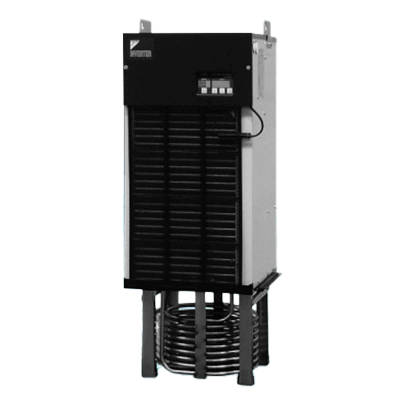What Is an Oil Cooler?

An oil cooler is a device that maintains the proper temperature of oil used in machinery.
While a device that regulates the temperature of air is called an “air conditioner,” an oil cooler, as the name suggests, controls the temperature of oil. The general structure is not much different from that of an air conditioner, which performs heat treatment through refrigerant gas.
Motor and bearing parts of a machine rotating at high speed generate heat, which may cause unexpected breakdowns or malfunctions. Oil coolers can efficiently remove heat from machines and thus have the ability to support the stable operation of machines.
Uses of Oil Coolers
Oil coolers are often used in machine tools such as machining centers and CNC lathes, which require high precision.
When a spindle rotates at high speed, thermal displacement occurs, adversely affecting machining accuracy. Therefore, by cooling the temperature of the oil used with oil coolers, thermal displacement can be minimized and stable continuous machining can be achieved.
Oil coolers can also be used when production sites using machine tools have problems, such as inconsistent machining accuracy or yield rates.
Principle of Oil Coolers
A typical oil cooler consists of a compressor that compresses air, a condenser, a decompression mechanism, and an evaporator.
- Compressor
In the compressor, refrigerant gas is subjected to high pressure, resulting in high temperature and high pressure. - Condenser
Refrigerant gas under high pressure in the compressor is cooled and condensed by air in the atmosphere, changing it into a liquid. - Pressure Reducing Mechanism
The high-temperature, high-pressure liquid is depressurized to a liquid that is easy to evaporate. - Evaporator
The liquid produced via the decompression mechanism is brought into contact with machine oil. The liquid then removes heat from the oil and evaporates, becoming a low-temperature, low-pressure gas. This phenomenon is called heat of vaporization and helps cool any substance.
Some of them are also equipped with inverters, while others are not. Without an inverter, temperature control can only be controlled by turning the operation on and off, resulting in a large error from the set temperature. If you want to control oil temperature with higher precision, it is common to choose one with an inverter.
Other Information on Oil Coolers
1. Benefits of Oil Coolers
The primary role of oil coolers is to keep the engine oil at the proper temperature. Engine oil is formulated to perform best at temperatures between 80-100℃.
Cooling the engine oil with oil coolers provides a variety of benefits. The most important effect is to maintain lubricity. Automobiles are made up of a combination of various metal parts such as gears, bearings, and sliding bearings called bushings.
Also, in an engine, the piston slides through the piston chamber. To reduce friction between these parts, oil is essential. By keeping the temperature of the oil in the proper range with oil coolers, the sliding resistance between parts is reduced and the machine can continue to operate normally.
Especially in the case of engines, as output increases, heat from exhaust gases, combustion chambers, and cylinder walls causes the engine oil temperature to rise. Therefore, the temperature is regulated using the power of cooling water. Note that water-cooled oil coolers can prevent the engine oil temperature from dropping too low compared to other oil coolers. This is because the coolant never gets lower than room temperature.
2. Performance Requirements for Oil Coolers
While sufficient cooling capacity is required for automotive oil coolers, there are various other requirements. First, they must be compact and lightweight. Since automobiles are required to have a large occupant space, components that fit inside the engine compartment must always be compact. Lightweight is also an important requirement in terms of fuel efficiency.
Another requirement is that the oil flow resistance must not be too large. If the oil flow resistance is too large, the amount of oil circulating will be reduced and the cooling capacity will also decrease. Also, in a low-temperature environment, the oil needs to warm up quickly. To warm up the oil quickly at low temperatures, it can be said that oil flow resistance is an important requirement.